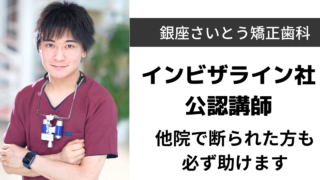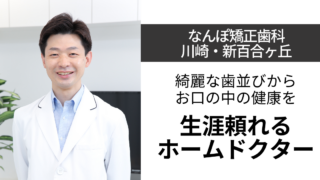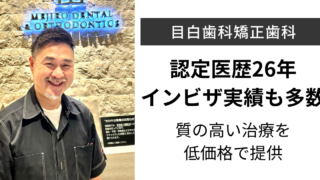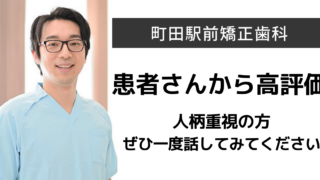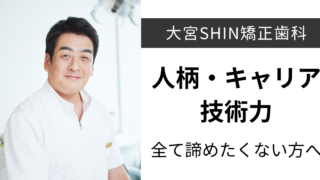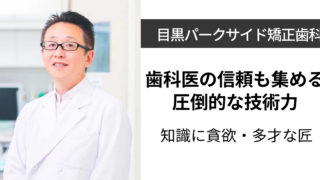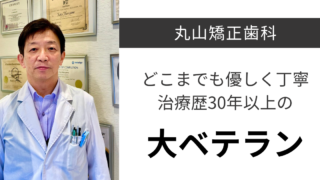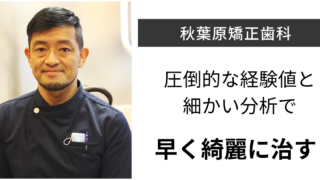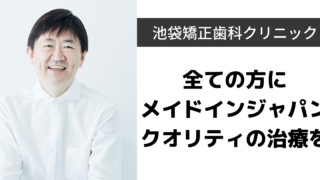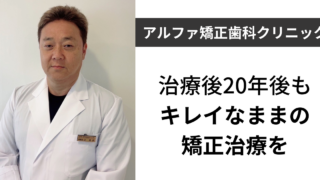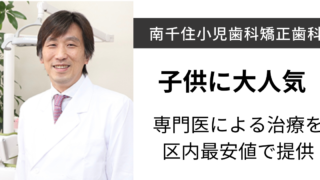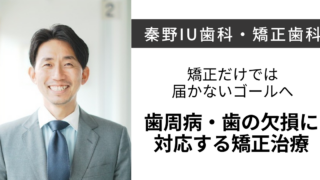
矯正でゴムかけしないと起こるリスクを歯科医師が解説!

先生、矯正のゴムかけがすごく面倒なんです。
口を開けると目立つし、やりたくないんですけど…

うーん、確かにゴムかけは大変だと感じる方も多いですよね。
でも、やらないと歯並びや噛み合わせがちゃんと整わないこともあるんです。
今回は、矯正でゴムかけしないと起こるリスクについてお話します!
矯正のゴムかけはなんのためにするの?

矯正のゴムかけは、小さい輪ゴムを上下の歯のワイヤーやマウスピースの切れ込みなどに引っ掛けて行います。
主に
- 見た目と噛み合わせの機能の改善
- 矯正の最終段階の調整
などに用いられます。
見た目と噛み合わせの機能の改善
上下の歯列にゴムで縦方向の力を加えることで、上の前歯を奥歯の方に引っ張って出っ歯を改善したり、下顎を引っ込めて受け口を改善したりします。
また、噛み合っていない上下の歯を噛み合わせるときにも用いられ、ゴムかけの位置や方向によって、さまざまな矯正効果を発揮します。
矯正の最終段階の調整
矯正の最終段階で、ワイヤーやマウスピースだけでは動かせなかった歯や部位に対してピンポイントで力を加えて、微調整をしたいときにも用いられます。
矯正のゴムかけをしないリスク

矯正のゴムかけをしないと、計画通りに歯並びや噛み合わせが整わないリスクがあります。
例えば、
- 出っ歯で前歯があまり後ろに引っ込まない
- 受け口の治りが悪くなる
- 上下の歯がしっかり噛み合わない
など、ゴムかけをしないと満足のいく歯並びにならない可能性があります。
最悪の場合は、ワイヤーとの力のバランスが崩れて噛み合わせが悪化する恐れもあり、治療期間が伸びる原因となるので注意しましょう。
矯正のゴムかけパターン4つ
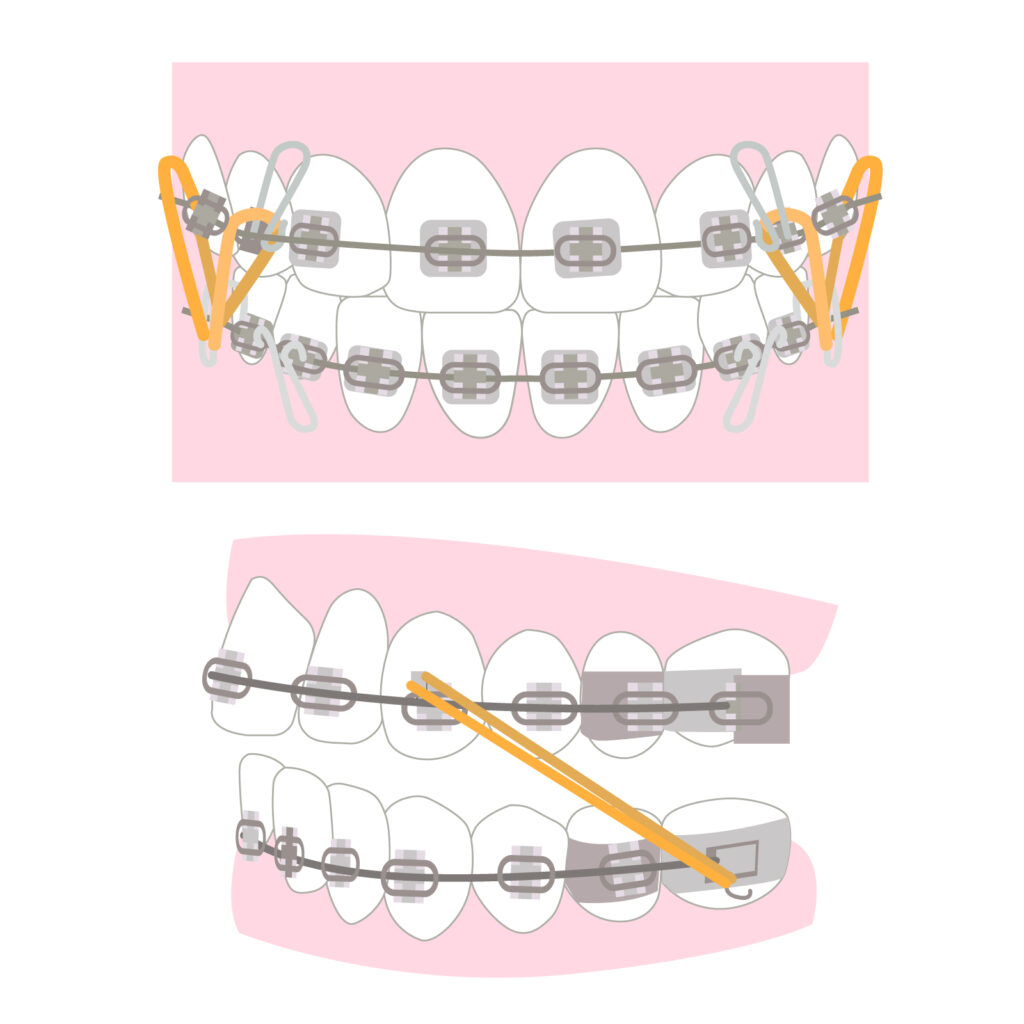
矯正のゴムかけの基本パターンは以下の4つです。
- 2級ゴム
- 3級ゴム
- クロスゴム
- 垂直ゴム
症例や動かしたい歯の方向によって、歯科医師がどのようにゴムかけをするか指示をします。
また、基本の4パターンのほかに、2本のゴムが斜め平行になるようにゴムをかけたり、左右のゴムかけの位置を不均一にしたりすることで、顎の位置や正中(※)を合わせることもあります。
※上下の歯の中心のライン
2級ゴム
2級とは、歯科用語で「出っ歯」のことです。(詳しくは1類・2類などにわかれます。)
2級ゴムは、左右それぞれの上の前歯の犬歯(前から3番目の歯)辺りと下の歯の奥歯に斜めにゴムをかけることで、
上の前歯を引っ込める作用と下顎を前に出す作用により、出っ歯を改善します。
3級ゴム
3級とは、歯科用語で「受け口」のことです。
3級ゴムは、左右それぞれの下の歯の犬歯辺りと上の奥歯に斜めにゴムをかけることで、下顎を後ろに下げて受け口を改善します。
クロスゴム
クロスゴムは、噛んだときに上下の歯が部分的に反対咬合になっている「交叉咬合(クロスバイト)」のときに使用します。
上の歯の内側と下の歯の外側にゴムをかけるなど、噛む面を跨いでゴムをかけることで、交叉咬合を改善します。
垂直ゴム
垂直ゴムは、噛んだときに前歯が噛み合わない「開咬(オープンバイト)」のときや、奥歯を噛み合わせるときなどに使用します。
垂直にゴムをかけることで、上下の歯を垂直方向に下ろして、噛むように誘導することができます。
矯正のゴムかけQ&A

矯正のゴムかけでよく聞かれる、3つの質問にお答えします!
- ゴムかけの使用期間
- ゴムかけの痛み
- ゴムかけの交換頻度
歯列矯正中のゴムかけの使用期間は?
矯正治療中のゴムかけの使用期間は、数ヶ月〜数年で症例によって異なります。
- 仕上げの最終段階で数ヶ月だけ必要な人
- 矯正の比較的初期から終了までずっと必要な人
- ゴムかけがまったく必要ない人
など、歯並びや噛み合わせの状態によって異なるため、歯科医師の指示に従いましょう。
矯正のゴムかけはいつまで痛い?
ゴムかけは歯に力をかけるため、ワイヤーやマウスピースで歯が動くのと同じく、2〜3日ほど痛みを感じることがあります。
長くても1週間ほどで落ち着くことがほとんどですが、ゴムを外している時間が長いと、ゴムを着けたときの痛みが長引く可能性があります。
矯正のゴムかけの交換頻度は?
矯正のゴムは、1日に最低1回の交換が目安です。
24時間以上同じゴムを使用すると、ゴムが伸びて適切な力がかからなくなります。
もし使用中にゴムが切れてしまった場合や、食事で外したときにゴムが伸びていると感じたら、新しいゴムに交換しましょう。
ゴムかけを効果的に行うポイント

ゴムかけを効果的に行うには、以下のことに注意しましょう。
- ゴムの装着時間を守る
- 鏡を見ながら支持された場所に確実にかける
- 外出時にはゴムの予備を持っておく
ゴムの装着時間を守る
ゴムの装着時間は、食事と歯磨き以外の20時間前後と支持されることが多いです。
支持されたとおりの装着時間を守りましょう。
装着時間を守らないと、歯が計画通りに動かなくなります。
鏡を見ながら支持された場所に確実にかける
ゴムは鏡を見ながら、支持された場所のワイヤーのフックやマウスピースの切れ込みに、きちんとゴムをかけるようにしましょう。
ゴムかけをする場所を間違えると、歯科医師が考えた通りに歯が動きません。
外出時にはゴムの予備を持っておく
外出時には、ゴムの予備を持ち歩くようにしましょう。
ゴムは何かの拍子に切れたり、口を開け閉めする力で伸びて緩くなったりすることがあります。
矯正のゴムかけは指示を守ってきちんと行いましょう

矯正のゴムかけは、歯並びや噛み合わせを整えるために必要です。
ゴムかけを支持された場合は、かける位置や装着時間を守って、きちんと行いましょう。
365detistでは、歯科医師運営のオープンチャットによるご相談や、あなたに合った歯科医院選びのお手伝いをしています!
お口のケアについてお悩みの方は、お気軽遊びに来てくださいね!
関連記事:きれいな歯並びの条件とは
関連記事:『出っ歯』と『口ゴボ』の違いってナニ?治し方や治療費用について
関連記事:【歯科医師解説】顎変形症治療で後悔しないために!費用や入院期間、流れを説明!
365dentist総監修 歯科医師/勝屋友紀子
長崎大学歯学部卒業、〜2018 九州医療センター、2018〜現在 都内歯科クリニック勤務
監修 歯科医師/Naomi
臨床研修終後、都内審美歯科勤務。現在は歯科医師/歯科ライター

